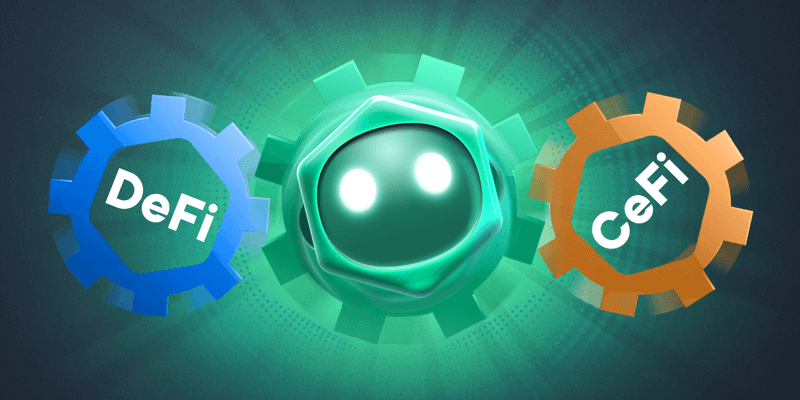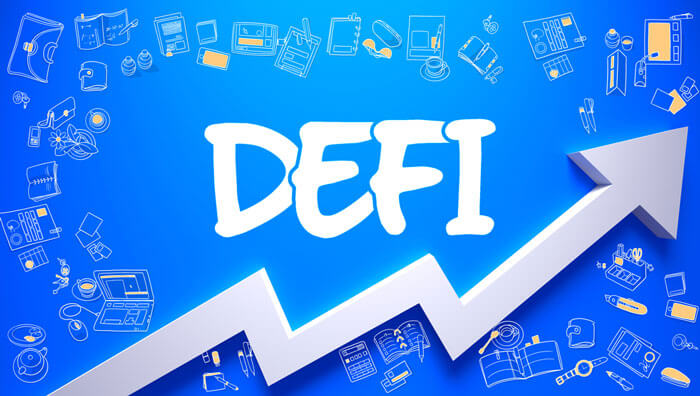The advent of the blockchain and Bitcoin ushered a new era of transformation in the financial sector. The latter’s successes catalyzed further innovations in this space. One of its earliest adaptations was Centralized Finance( CeFi). Further developments have seen the introduction of Decentralized Finance(DeFi).
Though the two are diametric opposites of each other, they serve one end: the expansion of financial services. But what do these concepts mean? What are their pros and cons? Can we find commonalities between the two? Finally, is there a way of bridging the divide between them?
This article will use the questions above to differentiate CeFi and DeFi investments. In this way, it aims at deepening your understanding of these crucial financial developments.
Understanding CeFi
CeFi is centralized finance and comprises closed financial markets. It entails a central authority controlling all aspects of transactions between peers. The said authority could be a bank, government, or any other uninvolved third party.
Salient Features of CeFi
A keen look at CeFi investments reveals several important features. First, there’s a strong emphasis on KYC and AML requirements. In keeping with their jurisdictions’ laws, CeFi service providers require their users to provide personal information, including identity and residence details.
Secondly, CeFi investments are custodial in that they hold their users’ private keys. They are centralized and offer cross-chain services. CeFi investment services also allow for the exchange of different cryptos issued on different blockchains.
Advantages of CeFi
The popularity of CeFi investments speaks of their usefulness. For instance, they guarantee the protection of depositors’ funds. As they’re custodial, CeFi service providers assure their users of the safety and returns on their users’ funds.
Additionally, they undertake to secure one’s private keys. Since the service provider holds the private keys, there’s no danger of ever losing them. Moreover, they have dedicated customer support systems.
Disadvantages of CeFi
There are several deficiencies linked to CeFi. Among these are higher transaction fees. Because they use intermediaries in transactions, they charge higher fees. Another shortfall is that they lack transparency as they don’t provide for a public audit of transactions.
The centralized nature denies users control over their funds and makes them invasive in nature. Their KYC requirements demand full disclosure of personal information. Users can quite easily lose their funds on these since CeFi investments are an easy target for hacking owing to their custodial nature.
Decentralized Finance (DeFi)
DeFi is an acronym for decentralized finance- a movement that champions the provision of P2P financial services. DeFi solutions give parties greater control over their transactions. They achieve this by eliminating centralizing authorities – banks and governments – from the exchanges.
Last year saw a proliferation of DeFi platforms. Currently, the major players in the space include Compound, Yearn Finance, Uniswap, and Marker DAO.
Key DeFi Features
A number of features define DeFi investment projects. To begin with, they are permissionless, which means that anyone can use them, regardless of their geographical location.
On top of that, they depend on Smart contracts, a set of code defining the relationship of the transacting parties. The smart contracts work together with Decentralized apps (Dapps) to automate transactions.
Again, DeFi investments are Blockchain-based. They run on the Ethereum blockchain and have wide applications across the payments, lending, and trading sectors.
Advantages of DeFi
The ballooning of DeFi projects points to them being beneficial. Here’s a rundown of their key advantages. A key feature is that DeFi investments give users autonomy over their funds. The user is the sole custodian of their investment.
Equally, it is expedient as it eliminates third parties, which helps to make it more affordable. Furthermore, DeFi investments are tradeable, thanks to tokenization, which allows for trading in micro-units.
Another key feature is that they’re accessible. DeFi investments are open to everyone, notwithstanding their location. They are also transparent since their deployment on the blockchain opens transactions to public scrutiny.
Disadvantages of DeFi
Although advantageous in many ways, DeFi platforms have their shortcomings. The threat of losing assets ranks highly among those. DeFi users may permanently lose their crypto assets by losing their private keys or mistyping their wallet addresses.
In close tow is the possible exposure to scams. Many cons have infiltrated the DeFi Sector. These take advantage of the absence of centralized control; victims have very little recourse, if any, in such cases.
Significant Differences Between DeFi and CeFi
The differences between CeFi and DeFi are more than in the terminology. As the following points will indicate, the two platforms are stark contrasts of each other.
Governance
Centralized authorities run all aspects of CeFi platforms. The users have to subscribe to a set code of regulations. On the contrary, DeFi platforms look to their user communities for governance. Some of them issue governance tokens that enable holders to participate in the decision-making processes. An example is Compound (COMP).
Features
Both CeFi and DeFi have unique features defining them. For example, CeFi projects are custodial while DeFi projects are non-custodial. Again CeFis offer dedicated customer services, which DeFis don’t.
Further CeFi investments adopt the use of Centralised Exchanges (CEX). On the flip side, DeFi investments use Decentralized Exchanges (DEXs).
Whereas CeFi projects are permissioned, DeFis aren’t. CeFis use third parties to create trust, while DeFis are trustless networks.
Regulation
CeFi platforms conform to strict regulations of the jurisdictions they operate. In compliance, they undertake thorough KYC and AML reviews of their users. On the other hand, DeFi is nascent and unregulated. They, therefore, dispense with KYC requirements.
That said, many jurisdictions are instituting regulatory measures in crypto operations. The Securities and Exchange Commission of the US oversees cryptocurrency trade. At the same time, the European Commission is pushing for a comprehensive legal framework targeting cryptos.
Fees
As CeFi runs centralized exchanges, they charge higher fees. The higher fees arise from the need to maintain the platform, pay their staff, improve their offering, among others.
In contrast, DeFi platforms are affordable. They employ decentralized exchanges that don’t provide custody services and don’t have teams engaging in their day to day running.
Liquidity
CeFi and DeFi investment platforms have different approaches to raising liquidity. CeFi projects raise liquidity by matching buyers’ and sellers’ orders akin to forex or stock markets. DeFi projects in reverse employ automated market makers that pre-fund both sides of the trade.
Security
The custodial nature of CEXs increases their susceptibility to cyberattacks. Although CeFi platforms invest in robust security systems, it isn’t unusual to hear of major platforms getting hacked.
DEXs, however, are noncustodial. Thus are less susceptible to such attacks. However, vulnerabilities in their smart contracts could expose them to the theft of funds.
Similarities Between DeFi and CeFi Investments
Although different, the two platforms find convergence in certain areas. For example, they offer similar financial services. These include trading (spot, derivatives, and margin), borrowing and lending, payments, and the development of stablecoins.
Also, both systems bank on innovation. They use transformative blockchain technology. Further, both serve the digital assets ecosystem.
Parting Shot
CeFi and DeFi platforms are polar opposite. That said, they serve similar functions in payments, lending, and trades. Moreover, both are at different stages of their development, with CeFi having a headstart over DeFi. This gap in development calls for urgent redress.
To that end, several projects and platforms are working on appropriate solutions. Binance is one of them. Apart from reducing the risks inherent in DeFi, there’s a need to mainstream it. Moreover, there must be a simplification of the DeFi adoption process besides building robust DeFi communities.


